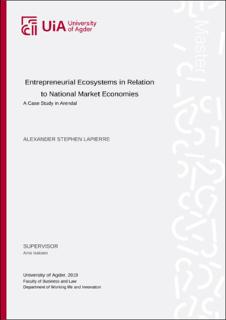| dc.contributor.author | Lapierre, Alexander Stephen | |
| dc.date.accessioned | 2020-03-13T12:11:41Z | |
| dc.date.available | 2020-03-13T12:11:41Z | |
| dc.date.issued | 2019 | |
| dc.identifier.uri | https://hdl.handle.net/11250/2646733 | |
| dc.description | Master thesis Innovation and Knowledge Development ME513 - University of Agder 2019 | en_US |
| dc.description.abstract | This paper discusses developments within the field of system approaches to regional economies. The focusof the paper is the approach that was developed in the last decade with a special focus on entrepreneurs within the regional system called the Entrepreneurial Ecosystem approach. While other system approaches primarily analyze institutions and the regions’ largest actors such as universities, big businesses, and the government, the Entrepreneurial Ecosystem (EE) focuses primarily on individual entrepreneurs and the dynamics between them and the institutionsand actors that support them. These dynamics work in conjunction to create entrepreneurial activity through innovative start-ups that together create value for the regional economy. This approach is still in the early stages of development and has received several criticisms from the academic community. One failing specified is the generality of the approach; there are no comparisons of EE presented, the presented idea is that every Entrepreneurial Ecosystem needs to be contextualized to the local region. This paper presents the first steps toward creating Entrepreneurial Ecosystem types that describe the kinds of entrepreneurship expected to develop in different types of nations. This was done through the synthesis of the Entrepreneurial Ecosystem approach with the Varieties of Capitalism (VoC) approach. The VoC approach presents markedly different national economies and the dynamics that contribute to their differences and competitiveness. This idea that different countries could have different but equally competitive economies was championed by the Varieties of Capitalism approach, as opposed to the conviction that one kind of economy is inherently better than all others. This approach defines two opposed ideal types for market economies: the Liberal Market Economy (LME), where businesses primarily relate to other actors through market relationships, and the Coordinated Market Economy (CME) where non-market relationships are most important. The differences between them are described as institutions that affect business decisions in five different spheres of influence. Applying these institutions to the EntrepreneurialEcosystems approach constructs different foundations and development paths for the ecosystem in each national economy. In general, the EEin anLME country is expected to have a stronger institutional support this well-developedEE will be largely independent and will create value through new industries in the region. In the CME country, less institutional support is expected, but large actors such as the government and business networks will be more likely to take a strong supporting role in the development of the ecosystem, so that the ecosystem creates value through supporting existing industries and businesses in the region. This paper also includes an empirical study done to test the theoretical findings of two kinds of expectations for EE. The case study of the Arendal region in the CME nation of Norway found that there seemed to be many similarities between the regional EE and theoretical expectations. But that further studies are required before this should be used in practice. | en_US |
| dc.language.iso | eng | en_US |
| dc.publisher | Universitetet i Agder ; University of Agder | en_US |
| dc.rights | Attribution-NonCommercial-NoDerivatives 4.0 Internasjonal | * |
| dc.rights.uri | http://creativecommons.org/licenses/by-nc-nd/4.0/deed.no | * |
| dc.subject | ME513 | en_US |
| dc.title | Entrepreneurial Ecosystems in Relation to National Market Economies : A Case Study in Arendal | en_US |
| dc.type | Master thesis | en_US |
| dc.subject.nsi | VDP::Samfunnsvitenskap: 200::Statsvitenskap og organisasjonsteori: 240::Offentlig og privat administrasjon: 242 | en_US |
| dc.subject.nsi | VDP::Samfunnsvitenskap: 200::Økonomi: 210 | en_US |
| dc.source.pagenumber | 54 p. | en_US |

